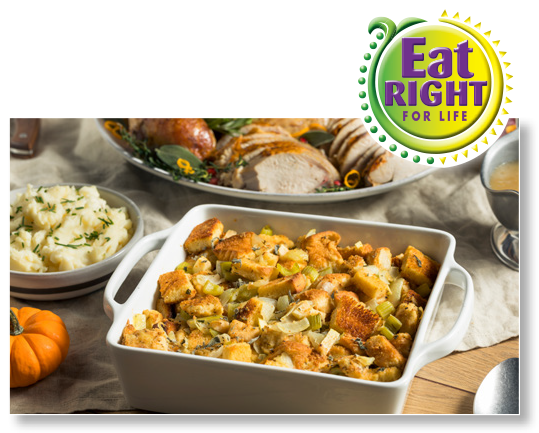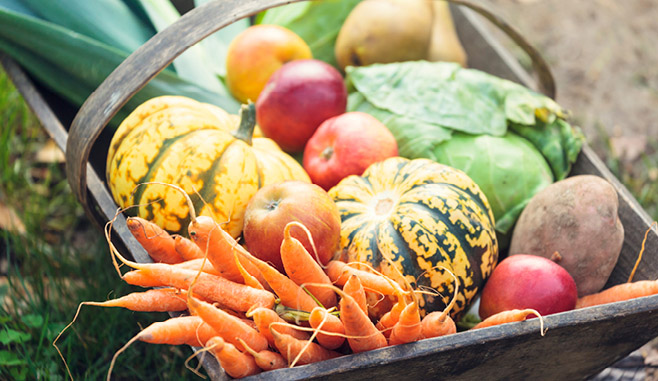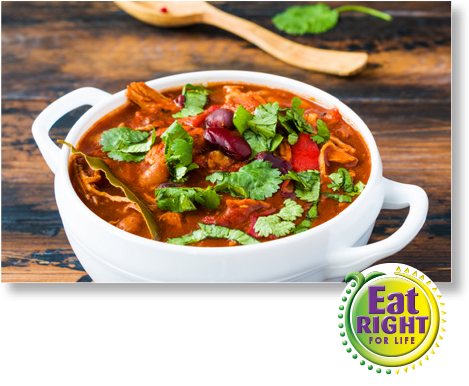

Dietitians Dish – November 16, 2020
Thanksgiving Dinner in 2020…

Try a new recipe for a traditional side dish – stuffing is one that lends itself to including more fruits and veggies in flavorful ways.
Instead of the same old stuffing, why not sweeten it up a bit? The flavors and textures of the added fruit, veggies, and nuts will make this a hit!
And, if your group is smaller, there’s many advantages:
• You’ll have plenty of leftovers to freeze for another time.
• It’s a great opportunity to waste less by planning future meals.
Pear – Walnut Stuffing

Ingredients:
- 1 Tbsp. olive oil
- 4 celery stalks, chopped
- 1 large carrot, peeled and chopped
- 1/2 small yellow onion, chopped
- 2 Bartlett pears, peeled, cored and chopped
- 1 cup toasted walnut pieces
- 2 Tbsps. chopped fresh sage
- 1 Tbsp. chopped fresh thyme
- 1 tsp. salt
- 1/2 tsp. ground black pepper
- 1 package (12 ounces) unseasoned, cubed stuffing
- 2 1/2 cups low sodium chicken broth
- 1/2 cup reduced sugar dried cranberries
Directions:
- Preheat oven to 400°. Spray 13 x 9-inch baking dish with cooking spray. In large skillet, heat oil over medium-high heat. Add celery, carrot and onion; cook 7 minutes, stirring occasionally. Add pears, walnuts, sage, thyme, salt and pepper; cook 5 minutesor until pears soften, stirring occasionally.
- In large bowl, gently combine stuffing, broth, cranberries and vegetable mixture; transfer to prepared dish and cover with aluminum foil. Bake stuffing 30 minutes; remove foil. Bake 15 minutes or until top is golden brown.

November 13, 2020
Fun Fact Friday
Believe it or not, pumpkin spice has NOTHING to do with pumpkins! It’s a blend of spices which include ground cinnamon, nutmeg, ginger, and cloves (and sometimes allspice). While it is commonly added to pumpkin pies for that spicy complement, its use has expanded beyond the pie crust. Many brands have introduced pumpkin spice flavored items into their seasonal goods for fall.
If you want to get in on the trend for all things pumpkin spice, buy a prepared seasoning or make your own. If you’ve got a stocked spice cabinet, you can create this thrifty favorite in just a couple minutes. Stir together and store in a clean jar or spice container with tight-fitting lid.
3 Tablespoons ground cinnamon
2 teaspoons ground ginger
2 teaspoons ground nutmeg
1-1/2 teaspoons ground allspice (optional)
1-1/2 teaspoons ground cloves

November 11, 2020
Wellness Wednesday – What’s in season?
With fall in full swing, and holiday menus on the horizon, it’s important to know what’s in season to get the most bang for your buck. When things are in season that means they’re at their peak of harvest and flavor. And, given they’re often at the highest supply this time of year, it’s the most cost-efficient time to buy.
During the months of October through December, many of the same items are considered in season. Now is the time that you’ll find the best deals on these seasonal items:
- Apples
- Broccoli
- Brussels Sprouts
- Carrots
- Cauliflower
- Citrus
- Cranberries
- Kiwi
- Leeks
- Parsnips
- Pears
- Pomegranates
- Rutabagas
- Sweet Potatoes
- Turnips
- Winter Squashes
The Healthy Family Project offers information throughout the year for what’s in season. Including more of these seasonal favorites will boost the nutrients in your menu, and may help defend against cold and flu season germs. I’d rather spend money on nutritious foods that taste great at this time of year than OTC cold medicines and doctor copays. Wouldn’t you?


Dietitians Dish – November 09, 2020
Take the Chill Off… with Chili!
Chili is another seasonal favorite comfort food that can be made healthier. All it takes is simple swaps or the right recipe to follow. With the right combination of ingredients mixed into the chili, you might only need a serving of fruit to create a MyPlate balanced meal.
• Add a variety of beans
• Choose a lean (90% or higher) ground meat
• Make it blenditarian by cooking ground meat with finely diced mushrooms
• Add extra veggies to increase valuable nutrients that benefit immunity
These are just a few ideas for making this comfort food better-for-you. Did you know that cooked tomatoes are one of the best sources of lycopene; an antioxidant that helps to protect against environmental damage to body cells? With the variety of veggies, beans and tomatoes in this lean turkey chili, you’re sure to please everyone around the dinner table.
Hearty & Healthy Turkey Chili

Ingredients:
- 2 Tbsps. olive oil
- 2 green or red bell peppers, chopped
- 2 medium celery stalks, chopped
- 2 medium yellow onions, chopped
- 4 garlic cloves, minced
- 1/4 cup chili powder
- 4 tsps. minced jalapeño pepper
- 1 tsp. ground cumin
- 1 tsp. ground red pepper
- 3 lbs. 93% lean ground turkey
- 1 can (6 ounces) tomato paste
- 1 can (28 ounces) crushed tomatoes
- 2 cups less-sodium chicken broth
- 1 can (15.5 ounces) no salt added cannellini beans, drained and rinsed
- 1 can (15.5 ounces) no salt added red kidney beans, drained and rinsed
- 1/4 cup chopped fresh cilantro
- Optional garnishes:sour cream or plain Greek yogurt, shredded cheese, diced avocado
Directions:
- In a large saucepot, heat oil over medium heat. Add bell peppers, celery and onions; cook 8 minutes or until vegetables begin to soften, stirring frequently. Stir in garlic, chili powder, jalapeño, cumin and ground red pepper; cook 1 minute.
- Increase heat to medium-high. Add turkey and cook 8 minutes or until browned, breaking up meat with side of wooden spoon. Stir in tomato paste; cook 1 minute. Stir in tomatoes and broth; heat to simmering. Reduce heat to medium-low; cover and cook 10 minutes, stirring occasionally. Stir in beans and cilantro; cook 5 minutes. Serve chili topped with garnishes, if desired. Makes about 16 cups so plenty of lunchtime leftovers!

November 7, 2020
Swap-it Saturday!
Without all the gatherings, sporting events, and other activities you might have been involved in pre-COVID, weekends are a good time to try out some better-for-you swaps. Could be simple things like using Greek yogurt instead of sour cream or replacing mashed potatoes with mashed cauliflower. When making these transitions you can swap 100% or start with a 50% blend of the old and new item to get your palate adjusted to a new taste and texture. If you’re eager to swap for a healthier version then jump in with both feet! At this time of year, you can easily find butternut squash and swap it for some cheese in a Mac & Cheese. Instead of potatoes for French fries or chips, you can also cut other types of tubers and root vegetables to look like these traditional forms of potatoes. They’re easily cut into shoestring or crinkle cut fry shapes or thinly sliced for “chips” and not hard to cook. Try these Parsnip fries in a simple, sheet-pan dinner.



